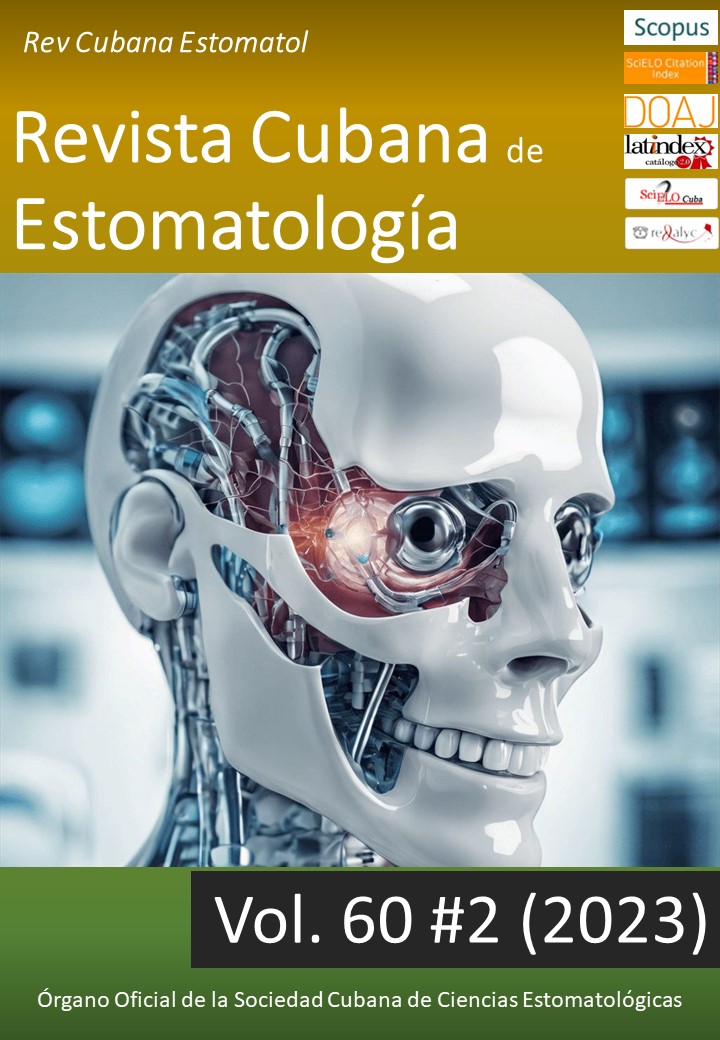Antifungal activity and physical characterization of an experimental dentifrice containing carvacrol
Keywords:
Candida albicans, dentifrices, candidiasis, oral, essential oil.Abstract
Introduction: The successful treatment of oral candidiasis depends on three essential principles, namely: early and accurate diagnosis, correlation with predisposing factors or underlying diseases that compromise immunity, and appropriate use of antifungal drugs.
Objectives: To determine the minimum inhibitory concentration of carvacrol against Candida albicans and to develop and evaluate the in vitro antifungal activity (diameter of inhibition zone) and physical properties (foaming capacity, spreadability and cleaning capacity) of an experimental dentifrice containing carvacrol.
Methods: The carvacrol was incorporated into a dentifrice base at different concentrations and tested for its minimum inhibitory concentration and agar diffusion against Candida albicans and the physical properties. Data were analysed by ANOVA.
Results: The minimum inhibitory concentration of carvacrol was 1041.67 ± 360.84 µg/mL. The dentifrice containing carvacrol C1 e C2 produced an inhibition zone of 27.50 ± 2.12 mm and 36.66 ± 2.08 mm, respectively (p<0.05). As for the physical properties, the dentifrices showed no foaming capacity, while their cleaning capacity and spreadability remained unaltered.
Conclusions: The experimental dentifrices containing carvacrol showed antifungal activity. The incorporation of carvacrol significantly altered the foaming capacity of the formulations, without any significant effects on their cleaning capacity and spreadability.
Downloads
References
Quindós G, Gil-Alonso S, Marcos-Arias C, Sevillano E, Mateo E, Jauregizar N, Eraso E. Therapeutic tools for oral candidiasis: Current and new antifungal drugs. Med Oral Patol Oral Cir Bucal. 2019;1;24(2): e172-80. DOI: 10.4317/medoral.22978
Gavaric N, Mozina SS, Kladar N, Bozin B. Chemical Profile, Antioxidant and Antibacterial Activity of Thyme and Oregano Essential Oils, Thymol and Carvacrol and Their Possible Synergism, J Essent Oil Bear. 2015;18(4):1013-21. DOI: 10.1080/0972060X.2014.971069
Suntres ZE, Coccimiglio J, Alipour M. The bioactivity and toxicological actions of carvacrol. Crit Rev Food Sci Nutr. 2015;55(3):304-18. DOI: 10.1080/10408398.2011
Silva ECAD, Leuthier LL, Almeida Júnior A, Nunes JMFF, Sampaio FC, Farias IAP. Physicochemical characteristics and antimicrobial activity of Origanum vulgare L. essential oil and carvacrol on cariogenic bacteria: an in vitro and in silico study. Nat Prod Res. 2022;36(24):6410-3. DOI: 10.1080/14786419.2022.2034809
Niu C, Wang C, Yang Y, Chen R, Zhang J, Chen H, Zhuge Y, Li J, Cheng J, Xu K, Chu M, Ren C, Zhang C, Jia C. Carvacrol Induces Candida albicans Apoptosis Associated With Ca2+/Calcineurin Pathway. Front Cell Infect Microbiol. 2020;30(10):192. DOI: 10.3389/fcimb.2020.00192
Clinical and Laboratory Standards Institute (CLSI). Reference Method for Broth Dilution Antifungal Susceptibility Reference Method for Broth Dilution Antifungal Susceptibility Testing of Yeasts. 2002. [access 09/01/2023] Document M27-A2. Available in: https://clsi.org/standards/products/microbiology/documents/m27/
Clinical and Laboratory Standards Institute (CLSI). Method for Antifungal Disk Diffusion Susceptibility Testing of Yeasts; Approved Guideline. 2018. [access 09/01/2023] Document M44-A2. Available in: https://clsi.org/standards/products/microbiology/documents/m44/
Ponce AG, Fritz R, Del Valle C, Roura SI. Antimicrobial activity of essential oils on the native microflora of organic Swiss chard. LWT-Food Scienc Technol. 2003;36:679-84. DOI: 10.1016/S0023-6438(03)00088-4
Ogboji J, Chindo IY, Jauro A, Boryo DEA, Lawal NM. Formulation, physicochemical evaluation and antimicrobial activity of green toothpaste on Streptococcus mutans. Inter J Adv Chem. 2018;6:108-13. DOI: 10.14419/ijac.v6i1.10808
Shaheena S, Chintagunta AD, Dirisala VR, Sampath Kumar NS. Extraction of bioactive compounds from Psidium guajava and their application in dentistry. AMB Express. 2019;9(1):208. DOI: 10.1186/s13568-019-0935-x
Zhang K, Zhang N, Weir MD, Reynolds MA, Bai Y, Xu HHK. Bioactive Dental Composites and Bonding Agents Having Remineralizing and Antibacterial Characteristics. Dent Clin North Am. 2017;61(4):669-87. DOI: 10.1016/j.cden.2017.05.002
Paolone G, Scolavino S, Gherlone E, Spagnuolo G, Cantatore G. The "Pre-Finishing" Approach in Direct Anterior Restorations. A Case Series. Dent J. 2021;9(7):79. DOI: 10.3390/dj9070079
Sartoratto A, Machado ALM, Delarmelina C, Figueira GM, Duarte MCT, Rehder V LG. Composition and antimicrobial activity of essential oils from aromatic plants used in Brazil. Braz J Microbiol. 2004;35:275-80. DOI: 10.1590/S1517-83822004000300001
Bedre AS, Arjunkumar R, Muralidharan NP. Evaluation of Concentration Dependent Antimicrobial Efficacy of Herbal and Non Herbal Dentifrices Against Salivary Microflora – An In Vitro Study. BPJ. 2018;11:711-8. DOI: https://dx.doi.org/10.13005/bpj/1424
Resende AHM, Farias JM, Silva DDB, Rufino RD, Luna JM, Stamford TCM, Sarubbo LA. Application of biosurfactants and chitosan in toothpaste formulation. Colloids Surf B Biointerfaces. 2019; 1(181):77-84. DOI: 10.1016/j.colsurfb.2019.05.032
Published
How to Cite
Issue
Section
License
Authors retain all rights to their works, which they can reproduce and distribute as long as they cite the primary source of publication.
The Rev Cubana Estomatol is subject to the Creative Commons Attribution-Non-Commercial 4.0 International License (CC BY-NC 4.0) and follows the publication model of SciELO Publishing Schema (SciELO PS) for publication in XML format.
You are free to:
- Share — copy and redistribute the material in any medium or format.
- Adapt — remix, transform, and build upon the material.
The licensor cannot revoke these freedoms as long as you follow the license terms.
Under the following terms:
Attribution — You must give appropriate credit, provide a link to the license, and indicate if changes were made. You may do so in any reasonable manner, but not in any way that suggests the licensor endorses you or your use.
- NonCommercial — You may not use the material for commercial purposes.
No additional restrictions — You may not apply legal terms or technological measures that legally restrict others from doing anything the license permits.
Notices:
- You do not have to comply with the license for elements of the material in the public domain or where your use is permitted by an applicable exception or limitation.
- No warranties are given. The license may not give you all of the permissions necessary for your intended use. For example, other rights such as publicity, privacy, or moral rights may limit how you use the material.


